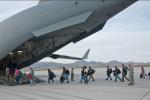Secretary Chu and Rosatom General Director Sergey Kiriyenko sigh the U.S.-Russia joint nuclear cooperation agreement. | Courtesy of Dan Leistikow
To say that Secretary Chu’s two days in Moscow have been busy is a bit of an understatement. His days were filled with meetings, speaking engagements and the U.S.-Russia Energy Working Group meeting. The Working Group is part of the broader Administration effort to promote cooperation between the U.S. and Russia.
Most notably, the Secretary signed two important energy agreements. The first was cosigned with Rosatom General Director Sergey Kiriyenko regarding U.S.-Russia joint nuclear cooperation. The agreement builds on past nuclear cooperation and includes support for national and international efforts on nonproliferation of nuclear weapons, for advancing research efforts and for the development of a legal framework to expand joint activities between our countries on nuclear research.
Secondly, Secretary Chu signed a joint statement with Russian Minister of Energy Sergei Shmatko following the Energy Working Group meeting concerning their action plan for the coming year. There are many facets to this plan, including a previously announced Smart Grid sister city project between San Diego and Belgorod, an Energy Savings Performance Contract pilot program in development in St. Petersburg and several clean energy joint research projects. The St. Petersburg project, in particular, would be the first of its kind in Russia and is designed to improve energy efficiency while lessening the up-front costs that might deter cities from installing more efficient systems in their existing public buildings.
Energy Cooperation Moving Forward
Discussions with Russia’s Federal Grid Company, which maintains the country’s electrical grid, showed that Russia and the U.S. face many of the same challenges. Both countries have an aging power distribution network spread over a vast area of land. Roughly two thirds of Russia’s transmission lines are more than 25 years old. And, in recent years, Russia has dealt with costly blackouts in St. Petersburg and Moscow much like the infamous blackout that blanketed the northeastern United States in 2003. Another common challenge we face is energy storage. In fact, Indiana-based Ener1 is manufacturing cutting-edge lithium ion batteries that are being installed in Russia and will help improve the stability and reliability of their grid as they prepare for the 2014 Winter Olympics in Sochi.
And we continue looking for opportunities to learn from each other beyond just the modernization of the electrical grid. During this trip, the Secretary also toured a Russian LED manufacturing facility, witnessed nuclear material detection systems in action and discussed ongoing nuclear security cooperation. He met with Rusano, a Russian state-owned company developing nanotechnologies, members of the Russian Academy of Sciences and participated in a roundtable with climate change experts. Global problems are called that for a reason; we’re all dealing with them. And the best way to find a solution is to work together as we figure out how to improve nuclear security, find better ways to store and transmit energy and respond to future challenges.



